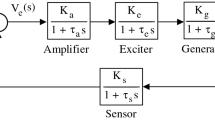Abstract
To enhance the controller performance, an advanced sine–cosine-algorithm (SCA) is employed for Fractional order PID (FOPID) controller tuning in this paper. The SCA-FOPID controller is based on model-based controller design method of physical systems to get better performance. The FOPID controller is designed by SCA optimization technique using the time domain objective function for AVR system. The SCA technique is responsible to optimize five parameters of FOPID controller based on minimum value of objective function of the controller design. The proposed SCA-FOPID controller is design at a global optimum of objective function is acheived. Then, the AVR system has good regulation of terminal voltage at the output to meet desired performance. The proposed method has a good reference tracking ability and frequency responses. This method is compared with the PID and FOPID controller designs of AVR system in the recent years, the proposed SCA-FOPID controller gives an excellent performance from the extensive simulations studies.

















Similar content being viewed by others
References
TangEmail Y, Zhao L, Han Z, Bi X, Guan X (2016) Optimal gray PID controller design for automatic voltage regulator system via imperialist competitive algorithm. Int J Mach Learn Cybern 7(2):229–240
Zamani M, Karimi-Ghartemani M, Sadati N, Parniani M (2009) Design of a fractional order PID controller for an AVR using particle swarm optimization. Control Eng Pract 17(2):1380–1387
Basu A, Mohanty S, Sharma R (2016) Designing of the PID and FOPID controllers using conventional tuning techniques. In: International conference on inventive computation technologies (ICICT), pp 1–6
Gaing Z-L (2004) A particle swarm optimization approach for optimum design of PID controller in AVR system. IEEE Trans Energy Convers 19(2):384–391
Gong C (2019) Jaya algorithm optimized PID controller for AVR system. In: Proceedings of the 3rd international conference on intelligent, interactive systems and applications (IISA2018), pp 384–393
Uniyal I, Sikander A (2018) A comparative analysis of PID controller design for AVR based on optimization techniques. Intell Commun Control Devices Adv Intell Syst Comput 624:1315–1323
Ramezanian H, Balochian S, Zare A (2013) Design of optimal fractional order PID controllers using particle swarm optimization algorithm for automatic voltage regulator (AVR) system. J Control Autom Electr Syst 24(5):601–611
Xiao L, Ying W, Ning L, Minyu H, Yinggan T, Fucai L (2017) Optimal fractional order PID controller design for automatic voltage regulator system based on reference model using particle swarm optimization. Int J Mach Learn Cybern 8(5):1595–1605
Sahu RK, Sekhar GC, Priyadarshani S (2019) Differential evolution algorithm tuned tilt integral derivative controller with filter controller for automatic generation control. Evolut Intell. https://doi.org/10.1007/s12065-019-00215-8
Jailsingh B, Ravi Kumar J (2019) PID controller design for decentralized TITO process using modified differential evolution algorithm. Mechatron Syst Control. https://doi.org/10.2316/J.2019.201-2947
Ahuja A, Aggarwal SK (2014) Design of fractional order PID controller for DC motor using evolutionary optimization techniques 3 evolutionary optimization. WSEAS Trans Syst Control 9:171–82
Sharma S, Kumar S, Sharma K (2019) Improved Gbest artificial bee colony algorithm for the constraints optimization problems. Evolut Intell. https://doi.org/10.1007/s12065-019-00231-8
Hafsi S, Laabidi K, Farkh R (2015) A new tuning method for stabilization time delay systems using \(P I^{\lambda } D^{\mu }\) controllers. Asian J Control 17(3):821–831
Lahcene R, Abdeldjalil S, Aissa K (2017) Optimal tuning of fractional order PID controller for AVR system using simulated annealing optimization algorithm. In: 5th international conference on electrical engineering—Boumerdes (ICEE-B), pp 1–6
Verma SK, Yadav S, Nagar SK (2017) Optimization of fractional order PID controller using grey wolf optimizer. J Control Autom Electr Syst 28(3):314–322
Zafer B, Karahan O (2018) A novel performance criterion approach to optimum design of PID controller using cuckoo search algorithm for AVR system. J Frankl Inst 355(13):5534–5559
Blondin a MJ, Sanchis J, Sicard P, Herrero JM (2018) New optimal controller tuning method for an AVR system using a simplified Ant Colony Optimization with a new constrained Nelder–Mead algorithm. Appl Soft Comput 62:216–229
Shah P, Agashe S (2016) Review of fractional PID controller. Mechatronics 38:29–41
Haji VH, Monje CA (2017) Fractional-order PID control of a chopper-fed DC motor drive using a novel firefly algorithm with dynamic control mechanism. Soft Comput 22(18):6135–6146
Podlubny I (1999) Fractional-order systems and controllers. IEEE Trans Autom Control 44(1):208–214
Roy P, Kar B, Kumar A, Roy BK (2016) Level control of two tank system by fractional order integral state feedback controller tuned by PSO with experimental validation. In: 2016 IEEE first international conference on control measurement and instrumentation, pp 224–228
Babu GS, Dinesh K (2015) Implementation of fractional order PID controller for an AVR system. In: IEEE international conference on energy power and environment: towards sustainable growth (ICEPE), pp 1–6
Charef A, Sun HH, Tsao YY, Onaral B (1992) Fractal system as represented by singularity function. IEEE Trans Autom Control 37(9):1465–1470
Mirjalili S (2016) SCA: a sine cosine algorithm for solving optimization problems. Knowl Based Syst 96:120–133
Nenavath H, Jatoth RK (2018) Hybridizing sine cosine algorithm with differential evolution for global optimization and object tracking. Appl Soft Comput 62:1019–1043
Panda S, Sahu BK, Mohanty PK (2012) Design and performance analysis of PID controller for an automatic voltage regulator system using simplified particle swarm optimization. J Frankl Inst 349(8):2609–2625
Parinya A, Zongli L (2017) Fractional order PID control of rotor suspension by active magnetic bearings. Actuators 6(1):1–31
Ekinci S, Hekimoglu B (2019) Improved kidney-inspired algorithm approach for tuning of PID controller in AVR system. IEEE Access 7:39935–39947
Author information
Authors and Affiliations
Corresponding author
Additional information
Publisher's Note
Springer Nature remains neutral with regard to jurisdictional claims in published maps and institutional affiliations.
Rights and permissions
About this article
Cite this article
Bhookya, J., Jatoth, R.K. Optimal FOPID/PID controller parameters tuning for the AVR system based on sine–cosine-algorithm. Evol. Intel. 12, 725–733 (2019). https://doi.org/10.1007/s12065-019-00290-x
Received:
Revised:
Accepted:
Published:
Issue Date:
DOI: https://doi.org/10.1007/s12065-019-00290-x




